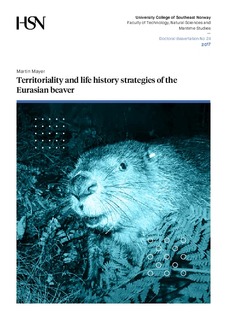| dc.contributor.author | Mayer, Martin | |
| dc.date.accessioned | 2018-02-02T14:04:36Z | |
| dc.date.available | 2018-02-02T14:04:36Z | |
| dc.date.issued | 2017-09-29 | |
| dc.identifier.isbn | 978-82-7206-442-5 | |
| dc.identifier.uri | http://hdl.handle.net/11250/2482443 | |
| dc.description.abstract | We studied life history strategies in the Eurasian beaver (Castor fiber), a territorial, monogamous, long-lived mammal, to increase our understanding of the mechanisms and trade-offs affecting the onset of natal dispersal, mate change, spatial movement patterns, and the duration of territory occupancy.
The mean age at dispersal in our study area was 3.5 years, with some individuals remaining within their natal family group until age 7. Subordinates delayed dispersal with increasing age of the same-sex parent. This suggests that either parents are more tolerant towards their offspring at an increasing age, or that subordinates can perceive senescence and thus ”queue” in the natal territory to take it over after the death of the parents. In addition, individuals were more likely to disperse with increasing age and at lower population densities. This suggests that subordinates gain competitive abilities with increasing age, and that they can perceive changes in population density. We found that subordinates often conducted extra-territorial movements, which lasted longer compared to extra-territorial movements by territory holders (dominants), and they usually intruded into multiple territories, which likely is a mechanism to detect a suitable timing for dispersal by gaining knowledge on available territories and population density fluctuations.
Further, we found that mate change in beavers was non-adaptive, most likely caused by the intrusion of a younger, incoming individual replacing the same-sex territory holder, and to a lower degree by the accidental loss of a partner. We then investigated spatial movement patterns of dominant beavers, and found that there was a territory size-dependent trade-off between patrolling and foraging: beavers in smaller territories had reduced costs of patrolling (they travelled at lower speed), but stayed further from the shore when foraging, possibly due to resource depletion. Beavers in smaller territories also conducted more extra-territorial movements, likely to assess possibilities for territory expansion. Additionally, older beavers spent more time on land and close to territory borders suggesting a behavioral change with age due to senescence or experience.
The duration of territory occupancy ranged between 1 and 11 years (mean ± SD: 6.2 ± 2.8 years), and was a predictor for the lifetime reproductive success of an individual. Beavers that delayed dispersal and established in intermediate-sized territories occupied them for longer compared to younger dispersers and individuals establishing in smaller or larger territories. This suggests that an individual should await its physical and behavioral maturation before the acquisition of a territory, and demonstrates that intermediate-sized territories follow the optimization criterion, ensuring sufficient resource availability and decreased costs of territorial defense at the same time.
The high population density in our study area is likely a major factor affecting many of the observed patterns, leading to an intense competition for territories, in effect causing delayed dispersal, non-adaptive mate change, and is driving spatial movement patterns related to patrolling and resource availability. | nb_NO |
| dc.language.iso | eng | nb_NO |
| dc.publisher | University College of Southeast Norway | nb_NO |
| dc.relation.ispartofseries | Doctoral dissertations at the University College of Southeast Norway;24 | |
| dc.relation.haspart | Paper I: Mayer, M., Zedrosser, A. & Rosell, F.: Beyond the border: The role of extra-territorial movements in a large, monogamous rodent. Manuscript. Submitted to Scientific Reports. A revised version of this paper has been published as Extra-territorial movements differ between territory holders and subordinates in a large, monogamous rodent. Scientific Reports 7(2017), 152651. http://dx.doi.org/10.1038/s41598-017-15540-0 | nb_NO |
| dc.relation.haspart | Paper II: Mayer, M., Zedrosser, A. & Rosell, F.: When to leave: the timing of natal dispersal in a large, monogamous rodent, the Eurasian beaver. Animal Behaviour 123(January), (2017), 375-382. http://dx.doi.org/10.1016/j.anbehav.2016.11.020 | nb_NO |
| dc.relation.haspart | Paper III: Mayer, M., Künzel, F., Zedrosser, A. & Rosell, F.: The 7-year itch: non-adaptive mate change in the Eurasian beaver. Behavioral Ecology and Sociobiology 71, (2017), 32. http://dx.doi.org/10.1007/s00265-016-2259-z | nb_NO |
| dc.relation.haspart | Paper IV: Graf, P.M., Mayer, M., Zedrosser, A., Hackländer, K. & Rosell, F.: Territory size and age explain movement patterns in the Eurasian beaver. Mammalian Biology 81(6), (2016), 587-594. http://dx.doi.org/10.1016/j.mambio.2016.07.046 | nb_NO |
| dc.relation.haspart | Paper V: Mayer, M., Zedrosser, A. & Rosell, F.: Couch potatoes do better: Delayed dispersal and territory size affect the duration of territory occupancy in a monogamous mammal. Ecology and Evolution 7(12), (2017), 4347-4356. http://dx.doi.org/10.1002/ece3.2988 | nb_NO |
| dc.rights.uri | http://creativecommons.org/licenses/by-nc-sa/4.0/deed.no | |
| dc.subject | behavioral ecology | nb_NO |
| dc.subject | dispersal | nb_NO |
| dc.subject | Castor fiber | nb_NO |
| dc.subject | life history | nb_NO |
| dc.subject | mate change | nb_NO |
| dc.subject | movement ecology | nb_NO |
| dc.subject | territoriality | nb_NO |
| dc.title | Territoriality and life history strategies of the Eurasian beaver | nb_NO |
| dc.type | Doctoral thesis | nb_NO |
| dc.description.version | publishedVersion | nb_NO |
| dc.rights.holder | © Martin Mayer, except otherwise noted | nb_NO |
| dc.subject.nsi | VDP::Mathematics and natural science: 400::Zoology and botany: 480::Ecology: 488 | nb_NO |

